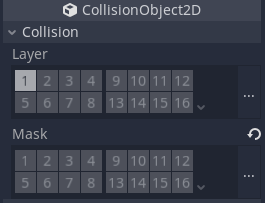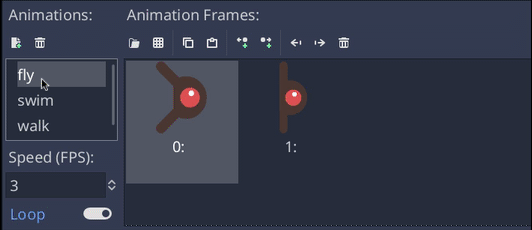Creating the enemy¶
Now it's time to make the enemies our player will have to dodge. Their behavior will not be very complex: mobs will spawn randomly at the edges of the screen, choose a random direction, and move in a straight line.
We'll create a Mob scene, which we can then instance to create any number
of independent mobs in the game.
Node setup¶
Click Scene -> New Scene and add the following nodes:
RigidBody2D (named
Mob)
Don't forget to set the children so they can't be selected, like you did with the Player scene.
In the RigidBody2D properties, set Gravity Scale
to 0, so the mob will not fall downward. In addition, under the
CollisionObject2D section, click the Mask property and uncheck the first
box. This will ensure the mobs do not collide with each other.

Set up the AnimatedSprite like you did for the
player. This time, we have 3 animations: fly, swim, and walk. There
are two images for each animation in the art folder.
Adjust the "Speed (FPS)" to 3 for all animations.

Set the Playing property in the Inspector to "On".
We'll select one of these animations randomly so that the mobs will have some variety.
Like the player images, these mob images need to be scaled down. Set the
AnimatedSprite's Scale property to (0.75, 0.75).
As in the Player scene, add a CapsuleShape2D for the collision. To align
the shape with the image, you'll need to set the Rotation Degrees property
to 90 (under "Transform" in the Inspector).
Save the scene.
Enemy script¶
Add a script to the Mob like this:
extends RigidBody2D
public class Mob : RigidBody2D
{
// Don't forget to rebuild the project.
}
// Copy `player.gdns` to `mob.gdns` and replace `Player` with `Mob`.
// Attach the `mob.gdns` file to the Mob node.
// Create two files `mob.cpp` and `mob.hpp` next to `entry.cpp` in `src`.
// This code goes in `mob.hpp`. We also define the methods we'll be using here.
#ifndef MOB_H
#define MOB_H
#include <AnimatedSprite.hpp>
#include <Godot.hpp>
#include <RigidBody2D.hpp>
class Mob : public godot::RigidBody2D {
GODOT_CLASS(Mob, godot::RigidBody2D)
godot::AnimatedSprite *_animated_sprite;
public:
void _init() {}
void _ready();
void _on_VisibilityNotifier2D_screen_exited();
static void _register_methods();
};
#endif // MOB_H
Now let's look at the rest of the script. In _ready() we play the animation
and randomly choose one of the three animation types:
func _ready():
$AnimatedSprite.playing = true
var mob_types = $AnimatedSprite.frames.get_animation_names()
$AnimatedSprite.animation = mob_types[randi() % mob_types.size()]
public override void _Ready()
{
var animSprite = GetNode<AnimatedSprite>("AnimatedSprite");
animSprite.Playing = true;
string[] mobTypes = animSprite.Frames.GetAnimationNames();
animSprite.Animation = mobTypes[GD.Randi() % mobTypes.Length];
}
// This code goes in `mob.cpp`.
#include "mob.hpp"
#include <RandomNumberGenerator.hpp>
#include <SpriteFrames.hpp>
void Mob::_ready() {
godot::Ref<godot::RandomNumberGenerator> random = godot::RandomNumberGenerator::_new();
random->randomize();
_animated_sprite = get_node<godot::AnimatedSprite>("AnimatedSprite");
_animated_sprite->_set_playing(true);
godot::PoolStringArray mob_types = _animated_sprite->get_sprite_frames()->get_animation_names();
_animated_sprite->set_animation(mob_types[random->randi() % mob_types.size()]);
}
First, we get the list of animation names from the AnimatedSprite's frames
property. This returns an Array containing all three animation names: ["walk",
"swim", "fly"].
We then need to pick a random number between 0 and 2 to select one of
these names from the list (array indices start at 0). randi() % n
selects a random integer between 0 and n-1.
Note
You must use randomize() if you want your sequence of "random"
numbers to be different every time you run the scene. We're going to
use randomize() in our Main scene, so we won't need it here.
The last piece is to make the mobs delete themselves when they leave the screen.
Connect the screen_exited() signal of the VisibilityNotifier2D node and
add this code:
func _on_VisibilityNotifier2D_screen_exited():
queue_free()
public void OnVisibilityNotifier2DScreenExited()
{
QueueFree();
}
// This code goes in `mob.cpp`.
void Mob::_on_VisibilityNotifier2D_screen_exited() {
queue_free();
}
This completes the Mob scene.
With the player and enemies ready, in the next part, we'll bring them together in a new scene. We'll make enemies spawn randomly around the game board and move forward, turning our project into a playable game.